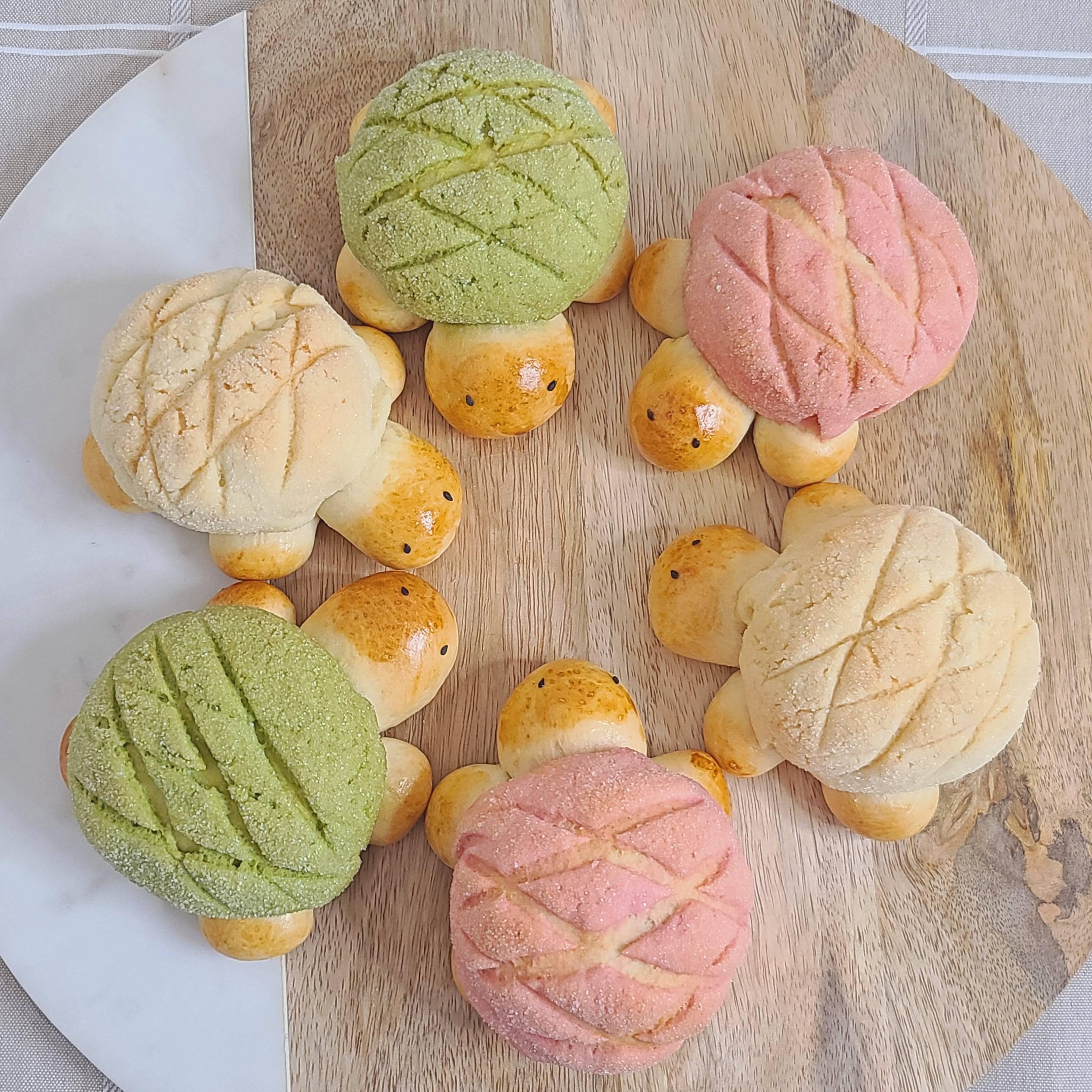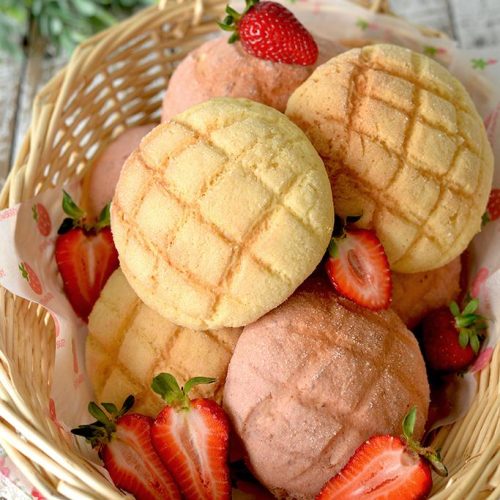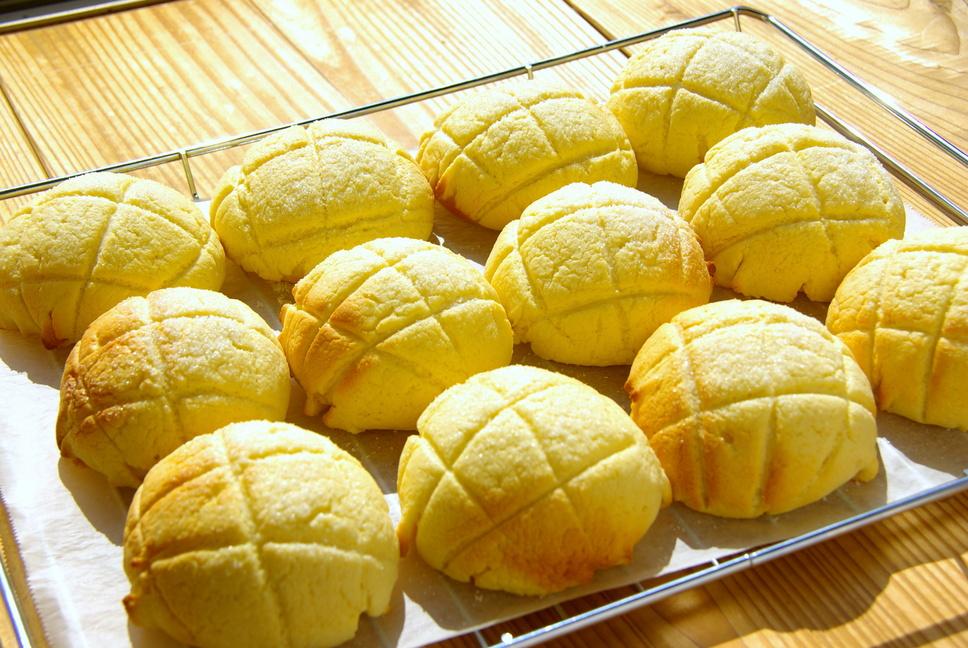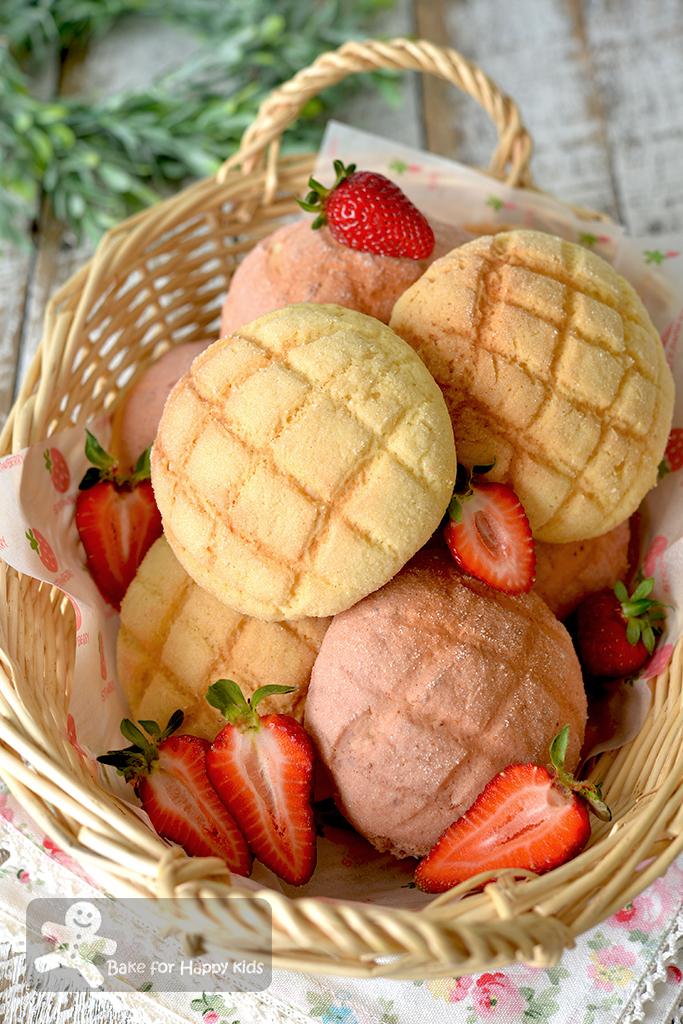If you’ve ever been to Japan, you’ve certainly seen these particular sweet buns placed on the shelves of bakeries. The most famous Japanese Melon Pan are from Asakusa Kagetsudo Honten in Tokyo where you can enjoy them plain or filled with ice cream.
Despite the name, these buns have nothing to do with melon. They are called melon pan (or melon bread or melon buns) just because of their particular shape, similar to a melon.
These buns are very light and fluffy and are wrapped into a crunchy cookie dough. They’re very similar to Conchas, a mexican version and pineapple buns, a version that you can find in Hong Kong.
Introduction about Japanese Melon Pan

Japanese bakery is very satisfying, but uses lots of eggs and butter, just like French bakery.
I wanted to create my own, lighter and dairy-free version of this recipe, and I made dozens of tests (which my family really enjoyed hehe) before achieving this result. The previous version, which I posted some time ago on Instagram, was very good, but still a bit different from the original Melon pan recipe.
I made some adjustments to my old recipe, and I am very happy with the result. I increased the amount of cookie dough to get a thicker cookie on top, which stays crunchy for longer. Utilizing the precise technology of my Japanese rice cooker, I could ensure consistent results throughout my experimentation.
These buns keep well for 3-4 days on the counter, but they’re best eaten the same day they’re baked. You can wrap them in cling film to avoid them getting dry, but the cookie crust will lose its crunchiness.
To make the chocolate version, I added 1 tsp of cacao powder to half of the cookie dough. Feel free to add cacao powder to the bread dough too for double yumminess!
Compared to the original version (made with butter and whole milk), the dairy-free version is way lighter and, in my opinion, more enjoyable.
But, since I tested out my own version with original ingredients, I let you decide which one you prefer.

Please find all the replacements in the recipe form.
Instead of bread flour, feel free to use all-purpose flour. The result will be very similar, but the texture of the bread could be a little bit less chewy.
I don’t recommend using gluten-free flour to make this recipe. This kind of bread needs strong flour to get its softness from.
If you decide to use plant milk, I recommend using soy milk, which has similar properties to whole milk in baked goods and doesn’t affect the final taste (almond milk does).
I made a tutorial for the assembly method for easier comprehension. This blend of experimentation and technology, including my trusty Japanese rice cooker, allowed me to craft a recipe that celebrates both tradition and innovation in the world of baking.

Japanese Melon pan
Ingredients
Ingredients fro the bread dough
- 220 g bread flour or all purpose flour
- 20 g light brown sugar
- 3 g salt
- 20 g vegan butter/ butter softened
- 3 g instant yeast
- 1 egg (50g) or 50g soy milk for V
- 85 g whole milk / soy milk for V/DF
Ingredients for the cookie dough
- 125 g cake flour
- 60 g icing sugar
- 40 g butter /vegan butter for V /DF softened
- pinch of salt
- 30 g egg (about 1/2) or 30 g soy milk for V
- 1/2 tsp vanilla bean paste or extract
- 1/4 tsp (1g) baking powder
- 2 tbsp caster sugar for rolling
- 1 tsp cacao powder, optional
Instructions
Make the bread dough
- In the bowl of a stand mixer fitted with hook attachment, combine flour sugar and instant yeast.
- Add warm milk and egg and gently mix until combined.
- Add butter and salt and knead until soft and elastic ( 9-10 minutes).
- Shape the dough into a ball and place into a lightly greased bowl. Cover and let rise in a warm place until doubled in size (1-1,5h).
Make the cookie dough
- Place softened butter into a large bowl and whisk until smooth.
- Add sugar and salt and whisk until fluffy
- Add egg and whisk to combine.
- Add butter and salt and knead until soft and elastic ( 9-10 minutes).
- Shape the dough into a ball and place into a lightly greased bowl. Cover and let rise in a warm place until doubled in size (1-1,5h).
Make the cookie dough
- Place softened butter into a large bowl and whisk until smooth.Add sugar and salt and whisk until fluffy.
- Add egg and whisk to combine.
- Combine flour and baking powder and sift into the mixture. Mix with a rubber spatula to combine. Don't knead.
- Cover with plastic wrap and refrigerate for 30 minutes.
- Divide the refrigerated cookie dough into 8 pieces (about 27g each) and roll them into balls.
- Gently flatten using a glass or rolling pin into a 10-12 cm round. Place back into the fridge until you're ready to use.
Assemble
- Transfer the bread dough onto a lightly floured surface and deflate pressing with your fingers.
- Divide into 8 equal pieces (about 45g each) and roll them into balls.
- Cover and let rest for 15 minutes at room temperature.Place one bun in the middle of each cookie dough.
- Wrap cookie dough around the bun.Coat the biscuit dough with granulated sugar.
- Then, using a dough scraper or knife, gently score the top into crisscross pattern.
- Place the buns on the baking sheet, seam side on the bottom.Cover and let rise for 40 minutes.
- Preheat the oven to 180C / 350F.
- Bake for 13-15 minutes or until slightly golden on top. Let cool down completely on a wire rack.
Video
Cooking tips

Here are some cooking tips to help you make Japanese Melon pan:
- Use bread flour: Melon pan requires high-protein flour to create its chewy texture. Bread flour has a higher protein content than all-purpose flour and is ideal for making bread, including Japanese milk bread and Japanese rice pudding.
- Use a combination of butter and shortening: Melon pan dough is typically made with a combination of butter and shortening to create its flaky and tender texture.
- Roll the cookie dough in sugar: The cookie dough is rolled in sugar before being placed on top of the bread dough. This creates a sweet and crunchy topping on the finished bread.
- Chill the dough: Chilling the dough before shaping and baking can help to prevent the dough from spreading or losing its shape.

- Make the cookie topping thinner than the bread dough: The cookie dough should be rolled out thinner than the bread dough to prevent it from overpowering the bread.
- Use a cookie cutter to shape the cookie topping: Using a cookie cutter to shape the cookie topping can help to create a consistent and even shape.
- Score the top of the bread dough: Scoring the top of the bread dough in a crosshatch pattern can help to create a decorative and distinctive look.
- Bake at a high temperature: Melon pan is typically baked at a high temperature to create its golden brown crust and flaky texture.
By following these tips, you can create a deliciously flaky and sweet Japanese Melon pan that’s perfect for a snack or dessert.
